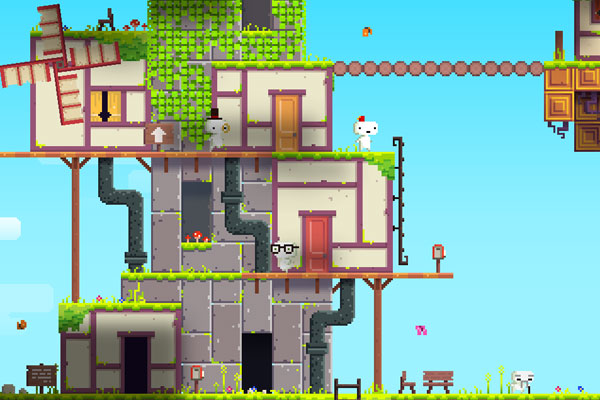Fez
Genre: Puzzle
Itís a fez. Fezzes are cool. In this case Gomez, the over-sized oblong-headed protagonist, is granted magical powers by a felt hat he finds in his two-dimensional pixel home. It grants him the insight to see his world in a whole new way.
Gomez is a ďprotagonistĒ in the loosest sense, because Fez doesnít have much of a plot. Itís never explained why Gomezís home is floating, alone, in a void in the middle of space. On the other hand, Fezís pixels are packed with more intricate details than almost any fully fledged 3D title. Messages scrawled on blackboards in rooms that you have no reason to enter, a seemingly useless guide and artifacts with elaborate patterns that serve no obvious purpose all add to a second layer, simmering away quietly below the surface Ė their enigma can suck in a player who takes the time to examine them.
Fezís central mechanic twists dimensions like a Moebius strip, but it does so in a way thatís immediately intuitive to the player. From the basic 2D perspective, the camera can be rotated 90į, providing four independent views of a single level. Essentially, the game ignores depth. If Gomez is standing at the far right of a level, and you flip the perspective, he can saunter forth, smugly, as if heís on the far left of the immediately preceding view Ė simply because he looks as if he should be able to. The first time you take advantage of this, and traverse an empty void, is incredibly satisfying.
It never gets quite as tough as you might expect it to. Most often, levels require you to climb a column by rotating it at each tier, until platforms line up in such a way that you can gain altitude. When you attempt to traverse a more complex piece of geometry, Swiss-cheesed with doorways and alcoves, things get more complex. Donít get me wrong, it remains joyous and satisfying for the duration of the game, but is nothing like as punishingly taxing as, say, Braid.
There are technical problems. An inconsistent frame-rate and bugs that kick you to the Xbox dashboard are frustrating, especially in a game that so cleverly uses ďpretendĒ bugs as part of its charming aesthetic.




